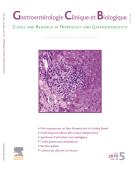Hépatite C et transplantation hépatique - 29/02/08
Tarik Asselah [1],
Hamza Boudjema [1],
Claire Francoz [1],
Rodolphe Sobesky [1],
Dominique Valla [1],
Jacques Belghiti [2],
Patrick Marcellin [1],
François Durand [1]
Mostrare le affiliazioniLa cirrhose d'origine virale C, associée ou non à une consommation excessive d'alcool, constitue la première cause de transplantation hépatique aux Etats-Unis et en Europe. La récidive virale C est quasi-systématique dans les semaines qui suivent la transplantation. L'histoire naturelle de la récidive virale C est variable d'un individu à l'autre. On estime à 30 % la probabilité de développer une cirrhose 5 ans après la transplantation hépatique. Environ 10 % des malades avec récidive virale C vont décéder ou nécessiter une seconde transplantation dans les 5 années suivant la transplantation. De nombreux facteurs, incluant ceux liés au virus, à l'hôte, à l'environnement et au donneur, sont vraisemblablement impliqués dans le pronostic. Le statut immunitaire joue un rôle majeur dans la sévérité de la récidive virale C ; avec une association entre d'une part une charge virale élevée et une immuno-suppression élevée et d'autre part une récidive virale C sévère.
Dans le cadre de la transplantation hépatique, le traitement anti-viral peut être discuté avant transplantation (malade sur liste d'attente), juste après la transplantation (au moment de l'hépatite aiguë sur le greffon) ou au stade d'hépatite chronique. De nombreuses études avec des nombres limités de malades ont évalué la réponse virologique prolongée entre 9-30 %. Les consensus ont proposé que le traitement soit instauré plus d'une année après la transplantation devant la constatation d'une fibrose avancée (supérieure ou égale à F2 au score METAVIR). La tolérance du traitement est mauvaise avec des taux élevés d'interruption et de modification de posologie. Dans cet article, nous proposons une mise au point sur la récidive virale C après transplantation, en insistant particulièrement sur la progression de la fibrose et le traitement anti-viral.
Hepatitis C and liver transplantation: fibrosis progression and treatment. Or how to improve management |
Hepatitis C virus-related end-stage liver disease, alone or in combination with alcohol, has become the leading indication for liver transplantation in most transplant programs accounting for approximately half of transplants performed in European centers. Hepatitis C virus infection recurs virtually in every post-transplant patient. The natural history of hepatitis C after liver transplantation is variable. Progression of chronic hepatitis C virus is more aggressive after liver transplantation with a cumulative probability of developing graft cirrhosis estimated to reach 30 % at 5 years. Approximately 10 % of the patients with recurrent disease will die or require re-transplantation within 5 years post-transplantation. Several factors, including those related to the virus, the host, the environment and the donor, are probably implicated in the outcome. The immune status represents the main significant variable in influencing disease severity in hepatitis C virus-infected patients; with higher HCV viral load and the significant association described between the degree of immunosuppression and disease severity.
Interventions to prevent, improve, or halt the recurrence of hepatitis C virus infection have been evaluated by multiple small studies worldwide with similar overall rates of virological clearance of approximately 9-30 %. Current consensus recommends combination therapy with pegylated interferon and ribavirin for those patients with histological recurrence of hepatitis C virus infection and fibrosis. Therapy is adjusted to tolerance and rescued with granulocyte colony-stimulating factor and erythropoietin for bone marrow suppression.
In this article we present a comprehensive review of post-transplant hepatitis C virus infection; in particular fibrosis progression and the major challenges according to treatment.
Mappa
© 2006 Elsevier Masson SAS. Tous droits réservés.
Vol 30 - N° 11
P. 1281-1295 - Novembre 2006 Ritorno al numeroBenvenuto su EM|consulte, il riferimento dei professionisti della salute.

